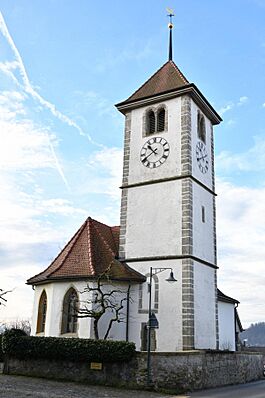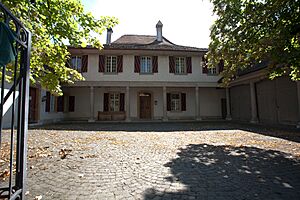Siselen facts for kids
Quick facts for kids
Siselen
|
||
|---|---|---|

Siselen village Reformed church
|
||
|
||
| Country | Switzerland | |
| Canton | Bern | |
| District | Seeland | |
| Area | ||
| • Total | 5.51 km2 (2.13 sq mi) | |
| Elevation | 460 m (1,510 ft) | |
| Population
(Dec 2020 )
|
||
| • Total | 612 | |
| • Density | 111.07/km2 (287.7/sq mi) | |
| Postal code |
2577
|
|
| Surrounded by | Bargen, Finsterhennen, Hagneck, Kallnach, Lüscherz, Walperswil | |
Siselen is a small town, also called a municipality, located in the Seeland area of the canton of Bern in Switzerland. It's a quiet place with a rich history.
Contents
History of Siselen
Siselen was first mentioned around the year 1160. Back then, it was known as Sisilli.
The oldest signs of people living here are tools and items from the Bronze Age. There was also a grave from the Hallstatt culture, an ancient European culture. For a long time in the Middle Ages, the village and its church were owned by the Counts of Neuchâtel-Nidau. They had "patronage rights," meaning they could choose the church's priest.
In 1388, the important city of Bern bought the village. Siselen then became part of Bern's "bailiwick" of Nidau. A bailiwick was like a district ruled by an official called a bailiff. Later, in 1803, Siselen was moved to the Erlach District, even though the villagers didn't want this change.
The village church was first mentioned in 1225. The church you see today, called St. Silvester, was built in 1500. It has been repaired and updated many times over the centuries.
Siselen grew up along the main road between Ins and Aarberg. People in the village grew crops and also took care of vineyards (places where grapes are grown for wine). In 1516, they got the right to collect tolls (money) from people using the Ins-Aarberg road. They used this money to keep the road in good condition.
A special set of rules for the village, called a "village charter," was first written down in 1736. A big project called the Jura water correction in 1874 helped drain the wet, marshy area known as the Grosses Moos. This made the rich soil good for farming. However, water levels rose again, so another water correction project was needed from 1970 to 1987. In 1916, a train station was built in Siselen, connecting it to the Biel-Täuffelen-Ins railroad. Siselen has mostly remained a farming community. In 2005, almost half of all jobs in the village were in agriculture.
Geography of Siselen
Siselen covers an area of about 5.5 square kilometers (2.1 square miles). A large part of this land, about 73.9%, is used for farming. Forests cover about 18.7% of the area.
About 7.1% of the land is built up with buildings and roads. A very small part, 0.2%, is made up of rivers or lakes. The remaining 0.4% is land that cannot be used for anything, like rocky areas.
Most of the built-up area is for houses and other buildings (3.1%). Roads and other transport areas make up another 3.1%. In the forested areas, 17.0% is dense forest, and 1.6% has orchards or small groups of trees. For farming, 70.1% of the land is used for growing crops, and 3.3% is used for pastures where animals graze. All the water in Siselen is flowing water, like rivers or streams.
The town is located on a "moraine," which is a hill or ridge formed by ancient glaciers. It sits at the northern edge of the Grosses Moos marsh. Siselen is a "linear village," meaning its buildings are mostly spread out along a main road.
On December 31, 2009, the old district of Erlach, where Siselen belonged, was closed. The very next day, January 1, 2010, Siselen became part of the new Verwaltungskreis Seeland administrative district.
Siselen's Coat of Arms
The blazon (official description) of Siselen's coat of arms is "Gules an Arrowhead Argent." This means the shield is red (gules) and has a silver (argent) arrowhead on it.
People of Siselen (Demographics)
Siselen has a population of about 569 people (as of 2023). In 2010, about 8.2% of the people living in Siselen were foreign nationals. Over the last ten years (from 2000 to 2010), the number of people living here went down by 11.1%. This was partly because some people moved away and partly because there were fewer births than deaths.
Most people in Siselen (about 94.9% in 2000) speak German as their main language. Albanian is the second most common language (2.0%), followed by Portuguese (0.8%). A few people also speak French or Italian.
In 2008, about 50.9% of the population was male and 49.1% was female. Most people were Swiss citizens. About 44% of the people living in Siselen in 2000 were actually born there. Another 37.1% were born in the same canton (Bern), while 9.5% were born elsewhere in Switzerland, and 7.5% were born outside Switzerland.
In 2010, young people aged 0–19 made up 21.8% of the population. Adults aged 20–64 made up 57.7%, and seniors (over 64 years old) made up 20.5%.
The chart below shows how the population of Siselen has changed over time:

Important Heritage Sites
The rectory (the house where the church's priest lives) in Siselen is very important. It is listed as a Swiss heritage site of national significance. This means it's a special building protected by the country. Also, the entire village of Siselen is part of the Inventory of Swiss Heritage Sites. This shows that the whole village has important historical and cultural value.
Economy of Siselen
In 2011, the unemployment rate in Siselen was quite low, at 1.6%. This means most people who wanted jobs had them. In 2008, there were 243 people working in the municipality.
Jobs in Siselen are divided into three main types:
- Primary sector: This includes jobs related to getting raw materials, like farming. In 2008, 99 people worked in this sector, mostly in agriculture. There were about 25 businesses in this area.
- Secondary sector: This includes jobs that make things, like manufacturing or construction. In 2008, 71 people worked here, with 7 businesses. About two-thirds of these jobs were in manufacturing, and one-third were in construction.
- Tertiary sector: This includes jobs that provide services, like shops, restaurants, or schools. In 2008, 73 people worked in this sector, with 22 businesses. Many of these jobs were in sales, transportation, or education.
In 2008, there were 179 full-time equivalent jobs. This means if you add up all the hours worked by full-time and part-time employees, it equals 179 full-time jobs.
Many people who live in Siselen travel to other towns for work. In 2000, 184 people left Siselen for their jobs, while only 35 people came into Siselen to work. This means Siselen sends out more workers than it brings in. About 11.1% of working people used public transportation to get to work, and 48.1% used a private car.
Religion in Siselen
Based on information from 2000, most people in Siselen belong to the Swiss Reformed Church (about 82.5%). About 7.7% of the population were Roman Catholic.
A smaller number of people belonged to other Christian churches (about 3.59%) or an Orthodox church (0.49%). There were also some people who followed Islam (about 2.61%). About 2.29% of the population said they didn't belong to any church, or were agnostic (not sure if God exists) or atheist (don't believe in God). A few people (2.45%) did not answer the question about their religion.
Education in Siselen
In Siselen, about 39.5% of the people have finished upper secondary education, which is like high school. About 7.7% have gone on to higher education, either at a university or a Fachhochschule (a type of professional college). Most of these people were Swiss men (80.9%) and Swiss women (17.0%).
The school system in the Canton of Bern works like this:
- One year of non-required Kindergarten.
- Six years of Primary school.
- Three years of required lower Secondary school. Here, students are grouped based on their abilities.
- After lower Secondary, students can continue their education or start an apprenticeship (learning a trade on the job).
During the 2010-2011 school year, 47 students attended classes in Siselen. There was one kindergarten class with 11 students. In this class, about 27.3% of the students were not Swiss citizens, and 18.2% spoke a different language at home than the one used in class. There were two primary classes with 36 students. About 22.2% of these students were not Swiss citizens, and 16.7% had a different mother language.
In 2000, 14 students came to Siselen from other towns to go to school. However, 53 students who lived in Siselen went to schools outside the municipality.
See also
 In Spanish: Siselen para niños
In Spanish: Siselen para niños





